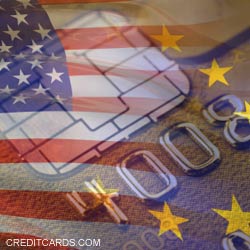7 reasons to accept smart cards
IBM researchers
helped develop the magnetic stripe on the back of credit cards in the 1960s as
a way to speed up back-office record keeping. Today, merchants throughout the U.S.
continue to process transactions using magnetic stripe readers, principally
because of comparatively low costs and entrenched habits.

However, a major
downside to processing magnetic stripe credit cards is that tech-savvy criminals can easily capture and clone magnetic
stripe data. The
Nilson Report
reveals that America now accounts for 47 percent of global credit and debit
card fraud -- despite generating only 27 percent of total purchases.
The
smart card solution
To combat the card fraud epidemic, European banks introduced chip-based
smart cards based on standards that Europay, MasterCard and
Visa (EMV) created in 1994.
Smart card chips encrypt account information, which blocks skimmers from
extracting directly usable data. European retailers adhere to a "chip-and-PIN"
standard that requires smart card users to enter their personal identification
number at checkout.
As a result, Europe has
significantly reduced card fraud for over a decade, as have other jurisdictions
that use smart cards, including Asia, Africa, Latin America, The Middle East and
Canada.
Getting with the EMV program
According to the Smart
Card Alliance, 1.2 billion smart cards have been issued worldwide,
serviced by 18.7 million chip terminals as of March 2011. Now, that number is set to increase. This past August, Visa announced plans to accelerate the U.S. migration to chip-secured
technology.
Now that Visa has put its weight behind EMV technology, it's a good time for American merchants to follow the card network's lead and adopt
EMV-compliant processors.
Here are seven key reasons why American businesses should upgrade their point-of-sale (POS)
processors to meet global EMV standards.
Reason No. 1: Tighten
security protection against fraud losses.
The
U.S. has become the destination of least resistance for global fraudsters that
target old magnetic stripe processors. By upgrading to EMV-compliant terminals,
U.S. merchants will eliminate many chargebacks from fraud-related losses. In
the United Kingdom between 2005 and 2007, the introduction of "chip-and-PIN" smart
cards reduced card fraud
losses
at U.K. retailers by 35 percent.
Reason No. 2: Shield against counterfeiting
liabilities.
Effective
October 1, 2015, Visa will shift financial responsibility for counterfeit transactions
onto the systems processor of any business that does not use contact chip
terminals. Merchants with EMV-enabled terminals will be exonerated from potentially
devastating costs that their systems processor would otherwise pass on. Fuel-selling
merchants have an extra two years to implement chip terminals before Visa's
liability shift to the merchant side takes effect.
Reason No. 3: Qualify for annual compliance
exemptions.
Effective
October 2012, businesses that process at least 75 percent of their Visa
transactions via EMV-compliant terminals during a given year will be exempted
from validating their compliance with Visa's PCI Data Security Standard for
that year. To qualify for Visa's audit pass, merchants must deploy EMV processors
capable of accepting both contact and contactless payments.
Reason No. 4: Increase sales via contactless and mobile
transactions.
Concurrent with its smart card initiative, Visa is also trying to persuade
merchants to accommodate contactless and mobile payments. As systems expert Allen Weinberg recently
commented, "Visa is fundamentally compelling all card-present merchants in the
U.S. to upgrade their card acceptance infrastructure to also support
contactless payments."
Weinberg also asserts that by offering multiple payment
methods, merchants can increase sales. This makes sense, given that Visa's
research shows that only about a quarter of Americans gravitate towards
PIN-based transactions and instead prefer contactless "tap and go" or "wave to
pay" payment options. Other analysts agree that mobile payments in the U.S. are
set to take off.
Reason No. 5: Serve customers faster.
Visa-championed
merchant systems upgrades not only enrich the customer experience via multiple
payment methods, chip-based purchases are typically much faster than magnetic
stripe transactions that require both online validation and customer signatures.
In Canada, where
contactless and mobile technology is already in place, Visa
Canada
explains that, "When a customer uses a Visa payWave terminal, the card or
mobile device and the terminal exchange security information and the
transaction is completed, all in less than one-third of a second. The
cardholder does not need to swipe a card or let it out of their possession,
keeping the transaction quick and secure."
Reason No. 6: Achieve global interoperability.
U.S.
merchants with EMV-compliant terminals can quickly process payments from
international visitors, including affluent shoppers from Canada, Brazil and
China. Americans who frequently travel can also use their smart cards to buy
more safely from merchants with stores in other countries. Interoperability
also permits convenient and secure purchases from e-commerce websites, no
matter where the seller's customers are located.
Reason No. 7: Improve
cardholder loyalty.
Smart
card chips can store information from multiple loyalty programs and clubs,
which also nurtures a superior buying experience. Because consumers can access many
different loyalty rewards from one smart card or mobile device, spending at
merchants with EMV-enabled processors becomes even more attractive.
See
related: MasterCard urges ATM owners to upgrade to EMV; A guide to Visa's merchant incentives
Published: December 8,2024




 Print
Print  Email
Email 